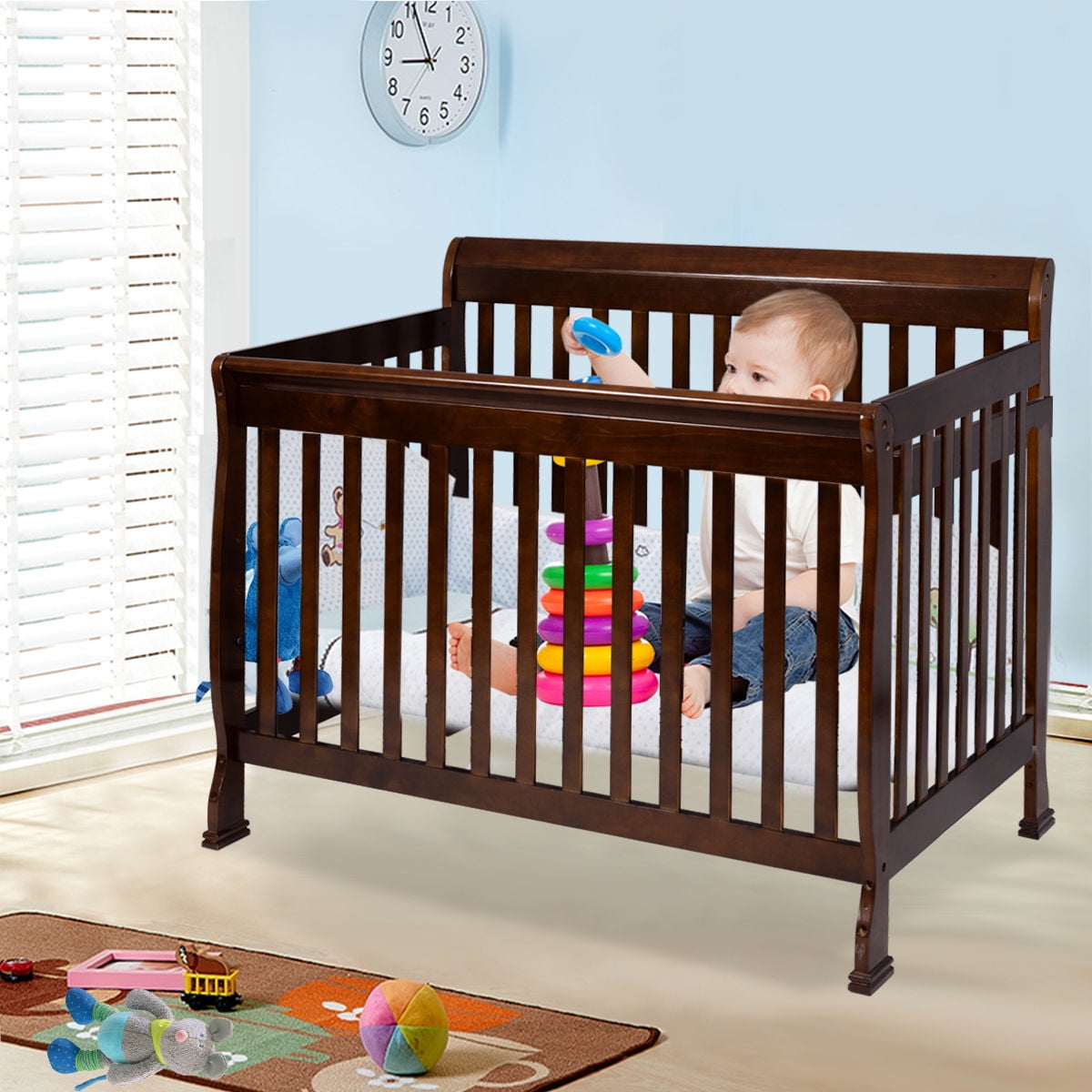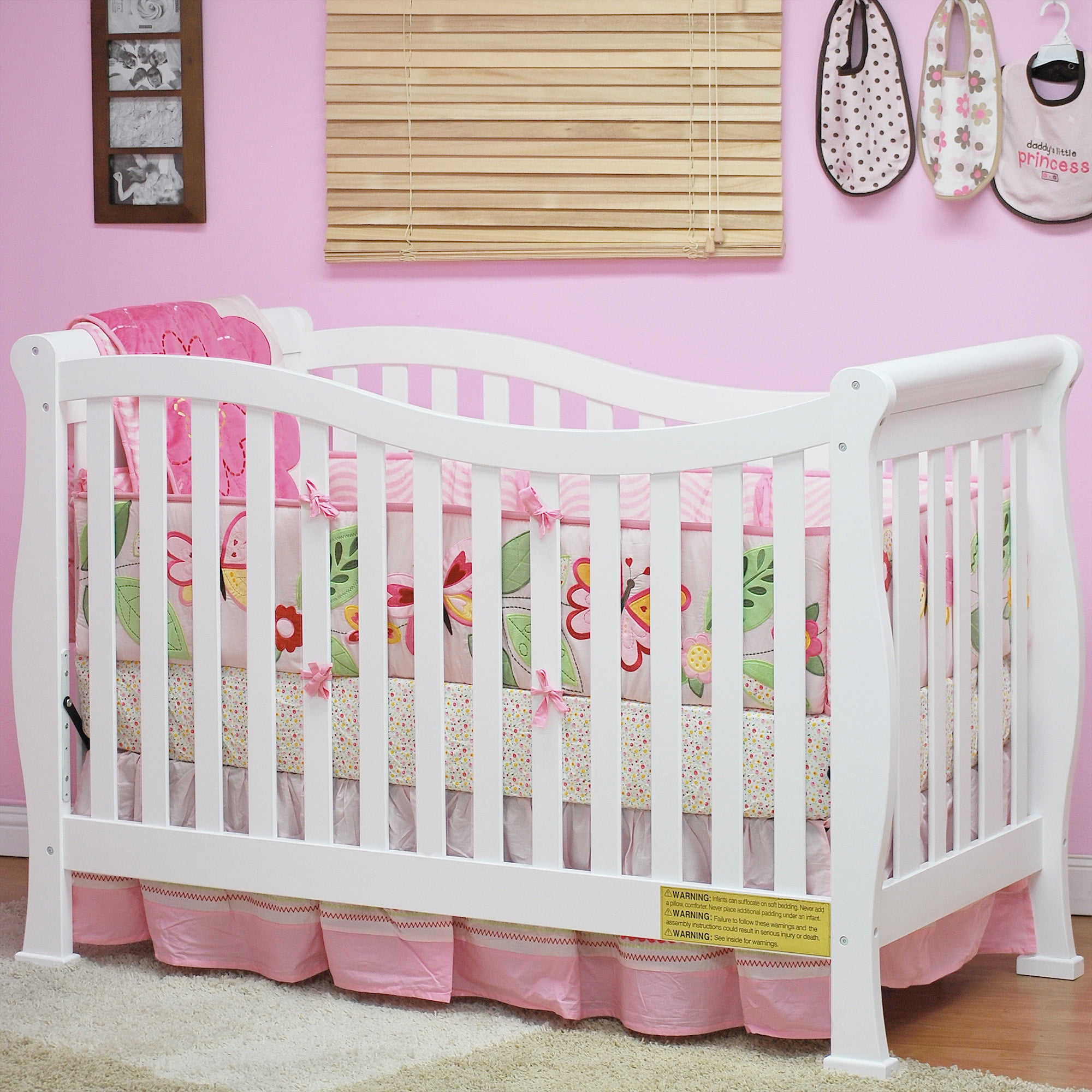Choosing the Right Size

Choosing the right crib size for your little one is crucial for their safety and comfort. The size of the crib should be a perfect fit for your baby’s growth and your bedroom’s space. This section will explore the various sizes available and help you make an informed decision.
Crib Sizes and Suitability
The size of a crib is important for the baby’s comfort and safety. It’s also important to choose a crib that will fit comfortably in your bedroom. Here’s a guide to different crib sizes and their suitability for different ages and baby sizes:
- Mini Crib: These are the smallest cribs, typically measuring 38″ x 24″. They’re perfect for newborns and infants up to about 6 months old. Mini cribs are ideal for small bedrooms as they take up less space. However, they may not be suitable for larger babies who grow quickly.
- Bassinet: Bassinets are even smaller than mini cribs and are designed for newborns only. They are usually lightweight and portable, making them ideal for small bedrooms and for moving around the house. However, they can’t be used for long as babies outgrow them quickly.
- Standard Crib: These are the most common type of crib, measuring 52″ x 28″. They are suitable for babies from birth up to toddlerhood. Standard cribs offer more space and can be used for a longer period.
Measuring Your Bedroom
To determine the ideal crib size for your bedroom, measure the available space. Consider the following:
- Measure the length and width of the space you’re considering for the crib.
- Leave at least 2 feet of space on all sides of the crib for easy access and movement.
- Measure the height of the ceiling to ensure the crib doesn’t obstruct the room’s lighting.
Comparing Crib Options, Small crib for bedroom
Here’s a comparison of the pros and cons of using a mini crib, bassinet, or standard crib for a small bedroom:
| Crib Type | Pros | Cons |
|---|---|---|
| Mini Crib | Saves space, portable, affordable | Limited lifespan, may not be suitable for larger babies |
| Bassinet | Very small, lightweight, portable | Short lifespan, not suitable for older infants |
| Standard Crib | Longer lifespan, provides more space, wider range of styles | Takes up more space, more expensive |
Safety Considerations
Safety is paramount when choosing a crib. Here are some key safety considerations:
Mattress firmness: A firm mattress is crucial to prevent suffocation. Choose a mattress that fits snugly in the crib and doesn’t leave any gaps.
Distance between slats: The distance between crib slats should be no more than 2 3/8 inches apart to prevent a baby’s head or limbs from getting trapped.
Features and Functionality: Small Crib For Bedroom

Choosing the right crib for your little one’s nursery is an exciting but important decision. You want a crib that’s safe, comfortable, and functional, especially if you’re working with a smaller space. Beyond just the size, you’ll need to consider several features and functionalities to ensure you’re getting the best crib for your needs.
Adjustable Height
The ability to adjust the height of the mattress is a crucial feature in a crib, especially for small bedrooms. It allows you to keep your baby safe and accessible at different stages of their development. As your baby grows, you can lower the mattress to prevent them from climbing out. Many cribs come with three or four height adjustments, offering flexibility as your child grows.
Convertible Options
Space-saving features are essential in a small bedroom. Look for cribs that can convert into a toddler bed, daybed, or even a full-size bed. This can save you money in the long run, as you won’t need to buy a new bed when your child outgrows the crib.
Storage Space
Storage is often a challenge in small bedrooms. Cribs with built-in storage drawers or shelves can help you keep your baby’s essentials organized and within reach. You can also consider adding a separate changing table with storage compartments to maximize space.
Innovative Design Features
Many modern cribs incorporate innovative design features that maximize space utilization. For example, fold-down cribs can be easily stored away when not in use, saving valuable floor space. Some cribs also come with built-in changing tables, eliminating the need for a separate piece of furniture.
Crib Materials
There are various materials used in crib construction, each with its own advantages and disadvantages.
- Wood: Wood cribs are durable, stylish, and often come in a variety of finishes. However, they can be more expensive than other materials and require regular maintenance to prevent scratches and water damage.
- Metal: Metal cribs are sturdy, affordable, and easy to clean. They are often lighter than wood cribs, making them easier to move around. However, metal cribs can be less aesthetically pleasing and may be prone to dents and scratches.
- Plastic: Plastic cribs are lightweight, affordable, and easy to clean. They are also available in a variety of colors and designs. However, plastic cribs can be less durable than wood or metal cribs and may not be as aesthetically pleasing.
Crib Feature Comparison
| Feature | Pros | Cons |
|---|---|---|
| Adjustable Height | Increased safety, convenience, and flexibility as the child grows | Can be more expensive than cribs without this feature |
| Convertible Options | Cost-effective, space-saving, and versatile | May be more expensive than non-convertible cribs |
| Storage Space | Keeps baby’s essentials organized and accessible | May be limited in some models |
| Fold-down Cribs | Space-saving, convenient for storage | May be more expensive than traditional cribs |
| Built-in Changing Table | Eliminates the need for a separate piece of furniture, convenient for diaper changes | May be less versatile than a separate changing table |
Styling and Aesthetics

Choosing a crib that complements your bedroom’s aesthetic is key to creating a cohesive and stylish nursery. Consider the overall vibe you’re going for and select a crib that harmonizes with the existing decor.
Crib Styles for Different Aesthetics
Crib styles can range from minimalist to traditional, each offering a unique look that can elevate your nursery’s design.
- Minimalist: Opt for clean lines, simple shapes, and neutral colors. Cribs with a sleek metal frame or a minimalist wooden design can create a modern and uncluttered look.
- Modern: Choose cribs with geometric shapes, bold colors, and unique materials like acrylic or metal. These cribs can add a touch of contemporary flair to your nursery.
- Traditional: Go for classic styles with intricate details, ornate carvings, and traditional finishes like cherry or mahogany. These cribs create a timeless and elegant ambiance.
- Rustic: Consider cribs made from reclaimed wood or featuring rustic finishes like distressed wood or weathered metal. These cribs bring a touch of warmth and natural beauty to the nursery.
Crib Colors and Finishes
The color and finish of your crib can significantly impact the overall feel of your nursery. Here’s a table showcasing some popular crib colors and their design impact:
| Color/Finish | Design Impact |
|---|---|
| White | Creates a bright, airy, and timeless look. It complements a wide range of nursery styles. |
| Gray | Provides a sophisticated and calming atmosphere. It pairs well with both modern and traditional decor. |
| Natural Wood | Offers a warm, rustic, and organic feel. It’s perfect for creating a cozy and inviting space. |
| Dark Wood | Adds a touch of elegance and sophistication. It complements traditional and modern nurseries with a touch of drama. |
| Colored Finishes | Can introduce a pop of personality and vibrancy. Choose colors that complement your nursery’s theme. |
Incorporating a Small Crib into a Small Bedroom
While a small crib can save space, it’s essential to ensure it doesn’t overwhelm the room. Here are some tips:
- Choose a Light Color: Opting for a white or light-colored crib can make the room feel more spacious. It helps to reflect light and create a sense of openness.
- Consider a Convertible Crib: Convertible cribs offer versatility as they can transform into a toddler bed or daybed, making them a practical choice for smaller bedrooms.
- Keep the Decor Minimal: Avoid cluttering the space with too many accessories. Choose a few essential items and prioritize functionality.
- Use Mirrors: Strategic placement of mirrors can create the illusion of more space, reflecting light and making the room appear larger.
Crib Accessories for Enhanced Visual Appeal
Crib accessories can add a touch of charm and personality to your small crib.
- Bedding: Choose soft and comfortable bedding in colors and patterns that complement the crib’s style. Consider using a patterned sheet and a solid-colored blanket for a balanced look.
- Blankets: A cozy blanket adds a layer of warmth and texture. Opt for a lightweight and breathable fabric for optimal comfort.
- Mobiles: A mobile can add a whimsical touch to the crib. Choose a design that complements the nursery’s theme and keeps your little one entertained.
Small crib for bedroom – A small crib can be the perfect addition to a cozy nursery, especially when you want to maximize space. Green and blue bedroom color schemes are a classic choice for nurseries, creating a calming and serene atmosphere. Check out these inspiring green and blue bedroom color schemes for ideas on how to create a tranquil haven for your little one.
Remember, a small crib doesn’t mean sacrificing style – there are plenty of beautiful and functional options available!
A small crib can be a cozy addition to a nursery, but when space is limited, maximizing every inch is key. This is where the principles of organizing a small master bedroom come in handy. Check out these space-saving tips for inspiration, then apply them to your nursery! You’ll be surprised how much you can achieve with clever storage solutions and a bit of creativity.
After all, a well-organized space makes for a peaceful and happy environment for both baby and parents.
